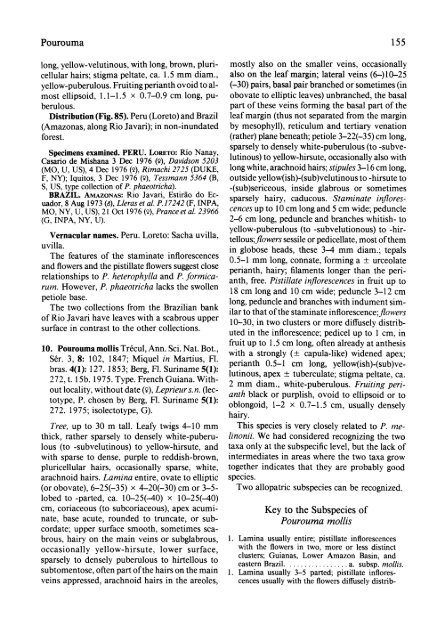Cecropiaceae: Coussapoa and Pourouma, with an ... - CNCFlora
Cecropiaceae: Coussapoa and Pourouma, with an ... - CNCFlora
Cecropiaceae: Coussapoa and Pourouma, with an ... - CNCFlora
You also want an ePaper? Increase the reach of your titles
YUMPU automatically turns print PDFs into web optimized ePapers that Google loves.
<strong>Pourouma</strong> 155<br />
long, yellow-velutinous, <strong>with</strong> long, brown, pluri- mostly also on the smaller veins, occasionally<br />
cellular hairs; stigma peltate, ca. 1.5 mm diam., also on the leaf margin; lateral veins (6-)10-25<br />
yellow-puberulous. Fruiting peri<strong>an</strong>th ovoid to al- (-30) pairs, basal pair br<strong>an</strong>ched or sometimes (in<br />
most ellipsoid, 1.1-1.5 x 0.7-0.9 cm long, pu- obovate to elliptic leaves) unbr<strong>an</strong>ched, the basal<br />
berulous.<br />
part of these veins forming the basal part of the<br />
Distribution (Fig. 85). Peru (Loreto) <strong><strong>an</strong>d</strong> Brazil leaf margin (thus not separated from the margin<br />
(Amazonas, along Rio Javari); in non-inundated by mesophyll), reticulum <strong><strong>an</strong>d</strong> tertiary venation<br />
forest.<br />
(rather) pl<strong>an</strong>e beneath; petiole 3-22(-35) cm long,<br />
sparsely to densely white-puberulous (to -subve-<br />
Specimens examined. PERU. LORETO: Rio N<strong>an</strong>ay,<br />
Casario de Mish<strong>an</strong>a 3 Dec 1976 (9), Davidson 5203 lutinous) to yellow-hirsute, occasionally also <strong>with</strong><br />
(MO, U, US), 4 Dec 1976 (9), Rimachi 2725 (DUKE, long white, arachnoid hairs; stipules 3-16 cm long,<br />
F, NY); Iquitos, 3 Dec 1976 (9), Tessm<strong>an</strong>n 5364 (B, outside yellow(ish)-(sub)velutinous to -hirsute to<br />
S, US, type collection of P. phaeotricha). -(sub)sericeous, inside glabrous or sometimes<br />
BRAZIL. AMAZONAS: Rio Javari, Estirao do Ecuador,<br />
8 Aug 1973 (8), Lleras et al. P.17242 (F, INPA,<br />
sparsely hairy, caducous. Staminate inflores-<br />
MO, NY, U, US), 21 Oct 1976 (v), Pr<strong>an</strong>ce et al. 23966 cences up to 10 cm long <strong><strong>an</strong>d</strong> 5 cm wide; peduncle<br />
(G, INPA, NY, U).<br />
2-6 cm long, peduncle <strong><strong>an</strong>d</strong> br<strong>an</strong>ches whitish- to<br />
yellow-puberulous<br />
Vernacular names. Peru. Loreto: Sacha<br />
(to -subvelutionous) to -hiruvilla,<br />
tellous;flowers sessile or pedicellate, most of them<br />
uvilla.<br />
in<br />
The features of the staminate inflorescences<br />
globose heads, these 3-4 mm diam.; tepals<br />
0.5-1 mm<br />
<strong><strong>an</strong>d</strong> flowers <strong><strong>an</strong>d</strong> the pistillate flowers suggest close<br />
long, connate, forming a ? urceolate<br />
peri<strong>an</strong>th,<br />
relationships to P. heterophylla <strong><strong>an</strong>d</strong> P.<br />
hairy; filaments longer th<strong>an</strong> the periformica<strong>an</strong>th,<br />
free. Pistillate<br />
rum. However, P. phaeotricha lacks the swollen<br />
inflorescences in fruit up to<br />
18 cm<br />
petiole base.<br />
long <strong><strong>an</strong>d</strong> 10 cm wide; peduncle 3-12 cm<br />
The two collections from the<br />
long, peduncle <strong><strong>an</strong>d</strong> br<strong>an</strong>ches <strong>with</strong> indument sim-<br />
Brazili<strong>an</strong> b<strong>an</strong>k<br />
ilar to that of the staminate<br />
of Rio Javari have leaves <strong>with</strong> a scabrous<br />
inflorescence;flowers<br />
upper<br />
surface in<br />
10-30, in two clusters or more<br />
contrast to the other collections.<br />
diffusely distributed<br />
in the inflorescence; pedicel up to 1 cm, in<br />
fruit<br />
10. <strong>Pourouma</strong> mollis Trecul, Ann. Sci. Nat.<br />
up to 1.5 cm long, often already at <strong>an</strong>thesis<br />
Bot., <strong>with</strong> a<br />
Ser. 3, 8: 102, 1847; Miquel in Martius, Fl.<br />
strongly (+ capula-like) widened apex;<br />
bras. 4(1): 127. 1853; Berg, Fl. Suriname<br />
peri<strong>an</strong>th 0.5-1 cm long, yellow(ish)-(sub)ve-<br />
5(1):<br />
272, t. 15b. 1975. Type. French Gui<strong>an</strong>a.<br />
lutinous,<br />
Withapex<br />
? tuberculate; stigma peltate, ca.<br />
2 mm<br />
out locality, <strong>with</strong>out date (2), Leprieur s.n.<br />
diam., white-puberulous. Fruiting peri-<br />
(lec- <strong>an</strong>th black or<br />
totype, P. chosen by Berg, Fl. Suriname<br />
purplish, ovoid to ellipsoid or to<br />
5(1):<br />
272.<br />
oblongoid, 1-2 x 0.7-1.5 cm, usually<br />
1975;<br />
densely<br />
isolectotype, G).<br />
hairy.<br />
This species is very closely related to P. melinonii.<br />
We had considered recognizing the two<br />
taxa only at the subspecific level, but the lack of<br />
intermediates in areas where the two taxa grow<br />
together indicates that they are probably good<br />
species.<br />
Two allopatric subspecies c<strong>an</strong> be recognized.<br />
Tree, up to 30 m tall. Leafy twigs 4-10 mm<br />
thick, rather sparsely to densely white-puberu-<br />
lous (to -subvelutinous) to yellow-hirsute, <strong><strong>an</strong>d</strong><br />
<strong>with</strong> sparse to dense, purple to reddish-brown,<br />
pluricellular hairs, occasionally sparse, white,<br />
arachnoid hairs. Lamina entire, ovate to elliptic<br />
(or obovate), 6-25(-35) x 4-20(-30) cm or 3-5-<br />
lobed to -parted, ca. 10-25(-40) x 10-25(-40)<br />
cm, coriaceous (to subcoriaceous), apex acumi-<br />
nate, base acute, rounded to truncate, or sub-<br />
cordate; upper surface smooth, sometimes sca-<br />
brous, hairy on the main veins or subglabrous,<br />
occasionally yellow-hirsute, lower surface,<br />
sparsely to densely puberulous to hirtellous to<br />
subtomentose, often part of the hairs on the main<br />
veins appressed, arachnoid hairs in the areoles,<br />
Key to the Subspecies of<br />
<strong>Pourouma</strong> mollis<br />
1. Lamina usually entire; pistillate inflorescences<br />
<strong>with</strong> the flowers in two, more or less distinct<br />
clusters; Gui<strong>an</strong>as, Lower Amazon Basin, <strong><strong>an</strong>d</strong><br />
eastern Brazil. ................ a. subsp. mollis.<br />
1. Lamina usually 3-5 parted; pistillate inflorescences<br />
usually <strong>with</strong> the flowers diffusely distrib-
















